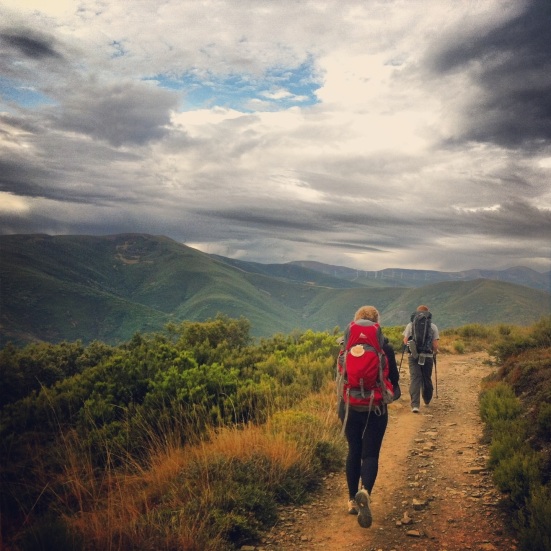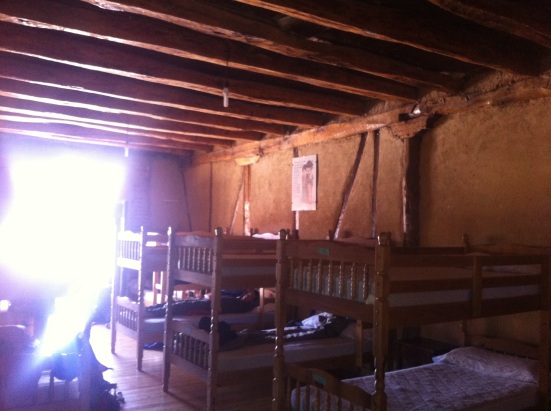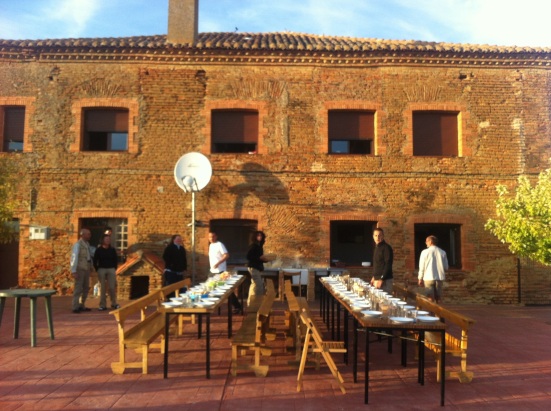There are so many beautiful things about life on the Camino.
The community, conversations, and culture. The scenery, self-reflection, and spirituality.
The opportunity to play lots of words games incorporating alliteration.

But what else did I love about my pilgrimage to Santiago?
The price.
Walking the Camino de Santiago is incredibly economical; one is able to travel for an extended period of time across Spain, without spending a ton of money. The lifestyle is simple and the cost reflects that.
Accommodations are limited to albergues, which are essentially low-budget hostels. Meals are generally very affordable, especially if you utilize the kitchen and prepare food yourself. Plus, there’s certainly no shopping, as the idea of adding anything else to your backpack is abhorrent.
So what exactly can you expect to spend?
Lodging – 7 euros per day
Costs vary, but expect to spend an average of 7 euros per night on accommodation. I stayed in many places that were 5 euros, some that were 10, and a few that were ‘pay-by-donation’ only. Don’t expect luxury. Don’t even expect comfort. An albergue is not your typical backpacker’s hostel. No sheets or towels are provided. The people-to-shower ratio translates into many a chilly rinse off. Wifi and/or computers are rare commodities. Bed bugs are an unfortunate reality, as I was quick to discover. Twice.
You’re totally convinced to go now, right?
But all that is part of what makes the Camino so wonderful. People of every age, religion, nationality, and profession are sleeping together under the same room. At the end of the day, it doesn’t matter how much money you make or where you’re from. I can honestly say that I haven’t a clue what 90% of the friends I made do for a living. Such a refreshing change from DC where the first question you ask someone is, “Where do you work?”. Plus, the no frills lifestyle enables a serious cleansing of mental clutter.
And despite all my warnings, most of the albergues I stayed at were clean and homely, and warrant no complaints.
Just don’t forget a sleeping bag, earplugs, and a sense of humor.
***If you’re still totally turned off by the idea of sharing a bedroom with 50 strangers, there are opportunities for a slightly more luxurious Camino experience. Hotels or privately owned albergues guarantee a little more comfort and occasionally some privacy. Various tour companies even offer pre-packaged deals that arrange nightly accommodation, dinners, and the occasional bag transfer for you. The lodging provided through most of these organizations is much more exclusive. However, there are sacrifices in coordinating your trip as such. One, the cost. It’s astronomically more expensive to stay in hotels or rent private rooms, rather than to stay in municipal albergues. Plus, those companies also charge a hefty rate for playing middle man in organizing your affairs. The other major sacrifice is that, by choosing to stay in more exclusive places, you are excluding yourself from other pilgrims. Most of the bonding and banter that goes on amongst pilgrims occurs in the evening hours at an albergue after a long day of walking, so please keep that in mind if you are considering this option.

Food – 12 euros per day
Eating can be really inexpensive on the Camino. During the day, most people stop in at little cafes for a quick sandwich and a chance to relax the legs. Spanish tortillas — not to be confused with Mexican tortillas — are delicious egg omelets often mixed with potatoes or sausage, and placed between two slices of thick, dry bread. I loved this meal as it is almost always under 5 euros, and bread and eggs just happen to be 2 of my favorite things in the world. However, a lot of people got tired of eating the same thing everyday. Ham and cheese sandwiches made with the same bread are also wildly popular, but beyond that, there isn’t a ton of variety.
Dinners are a different story. I’d say 60% of albergues have kitchens available for use, so you can always opt to make your own dinner. Preparing your own meals can be fun, especially when shared amongst a large group. PLUS, it’s a huge a money saver. The only pitfall is that most albergues are seriously lacking in spices, oils, etc., which can make cooking a bit more challenging. Whenever I made dinner, I tried to only buy things that I would consume that night as I felt guilty throwing things away but also had no intention of carrying leftovers in my backpack. The first year I walked the Camino, I spent two days with a bag of rice and a bottle of wine in my bag as the small towns I was staying in didn’t have an albergue with a kitchen. When I started muttering death wishes against the grains, I thought it best to chuck the load in a bin just for sanity’s sake.
Another possibility for dinner is to choose the Pilgrim’s Menu. Almost every restaurant will offer this option, which usually consists of a standard 3 course meal for 8-15 euros. These meals are also fun because you sit at a large table with a bunch of people from your albergue, which is a great way to interact with individuals you might not have otherwise approached. However, keep in mind that these dinners are usually massive, so be sure to bring your appetite.
Whatever you choose, just be sure to stay well nourished! It’s amazing the difference a snack makes when you’re walking 30 kilometers a day. My biggest piece of advice when it comes to food on the Camino? Eat lots of chocolate — its magical rejuvenating abilities extend beyond the world of Harry Potter.
Miscellaneous – 100 euros for entire trip
Of course, there are unexpected incidentals. I spent around 80 euros total on medication for my bed bug bites, blister ointments and preventative bandages, and gel insoles for my shoes. You may be lucky to fair better against these elements, but it’s best to plan for the possibility of anything happening.

So what is the total anticipated cost of walking the Camino?
Between 700-800 euros for a month of travel.
For 600 euros, you’d be really watching your budget. For any more, you’d be living luxuriously. I certainly don’t want to suggest that $1000 ISN’T a lot of money — it is. And really, price and affordability are ALWAYS relative terms. However, I doubt you’d be able to travel for a month in Europe for any less. What I spent during my month on Camino is equivalent to what I pay for one month’s rent in DC — the latter of which does not include food or any other living expenses. So, moral of the story, I’m being more financially responsible by frolicking around Spain than by staying home and counting quarters 🙂

Do you think the Camino is worth the cost? For those of you who have previously walked the Camino, what was your budget?



Another amazing post. I am going to forward this to Aunt Terry, hopefully one day we will do this together, the three of us if your are willing to go with a couple of old broads!!!! I truly love your writing!!!
Kathy Myers Vice President `Ailana Images 509.703.2673 kathy@ailana.com http://ailana360.com
Thanks mom 🙂
You almost have me convinced, not only to go but to go the economical route. That isn’t normally my style at all, which shows how persuasive your writing is!
Aww thanks! That’s the best compliment I could ask for.
PS. Go Zags!
This trip is definitely on my bucket list. The travel costs are very reasonable for Europe and I’d be happy to sleep in dorm rooms. My husband on the other hand likes his own space. I’m not sure I’d be able to talk him into this aspect of the Camino. Actually now that I think about it I’m not sure he’d be up for a month of walking either! I’ve got a lot of persuading to do.
Haha sounds like you’ve got a long road ahead of you — even before starting the Camino! Best of luck with the persuasion efforts!